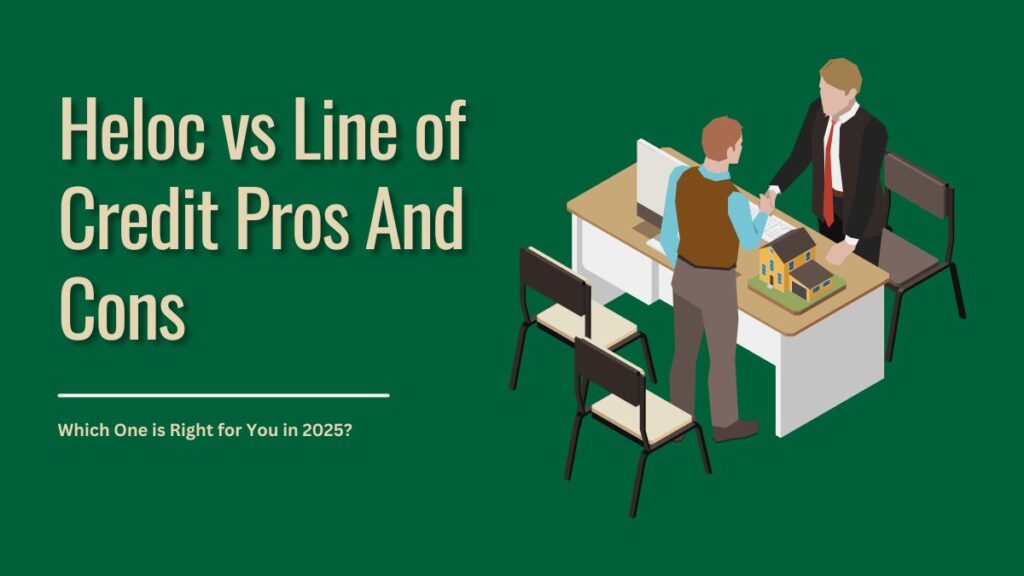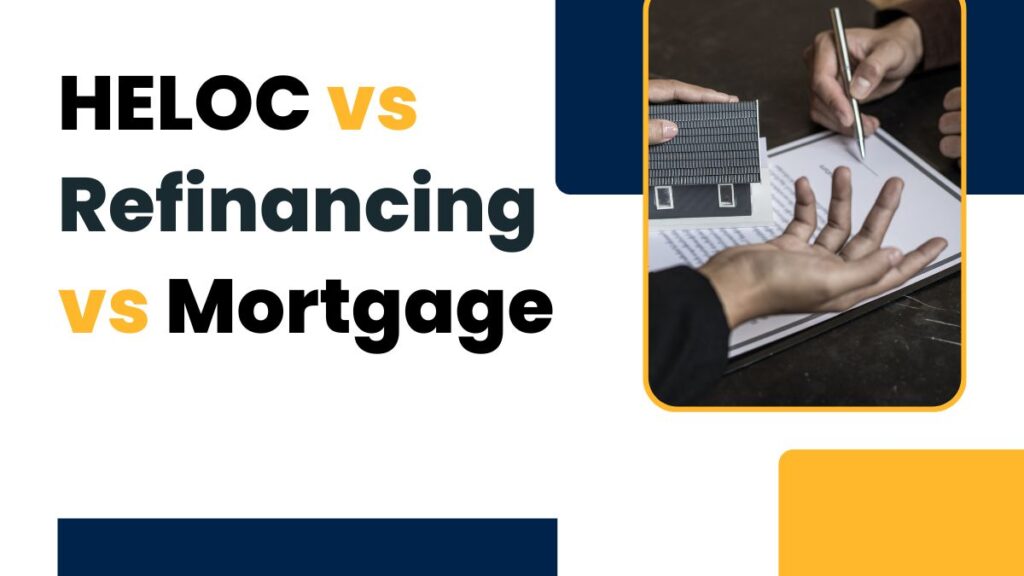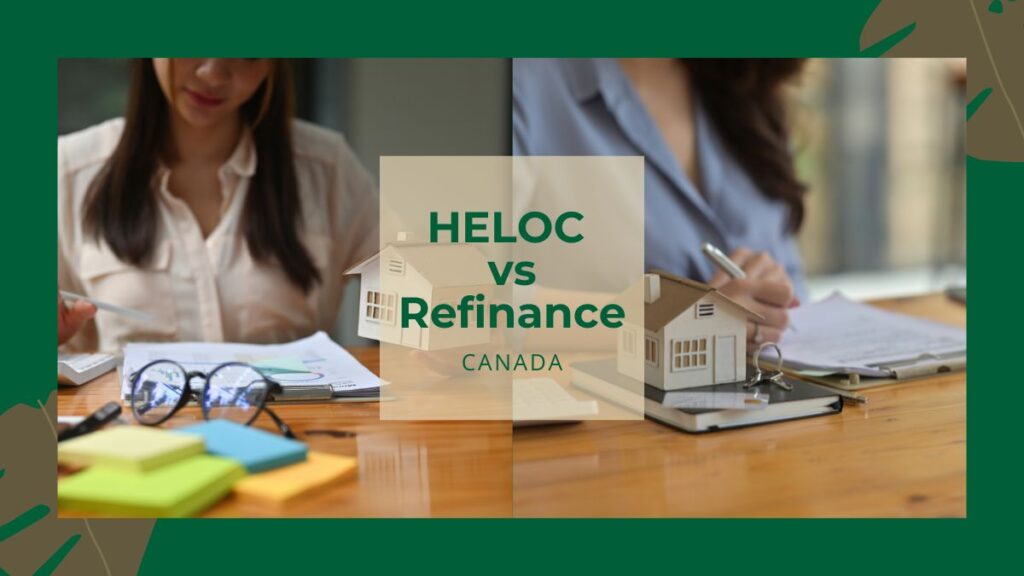Not sure whether to choose a HELOC or a traditional line of credit? Learn HELOC vs Line of Credit pros and cons, including their interest rates, flexibility, and repayment options, to help you make the right choice for your financial goals.
Choosing between a HELOC and a Personal Line of Credit requires a clear understanding of their differences and advantages. A HELOC acts like a credit card, secured by the equity in your home, while a Personal Line of Credit offers flexible access to funds without risking your property. So, which one aligns with your financial needs?
Quick insight: In 2025, Canadians are carrying over $170 billion in HELOC debt, marking a 3% increase from the previous year. Personal Lines of Credit are similarly common, providing flexibility but typically carrying higher interest rates.
In this post, we’ll analyze:
Let’s examine these options carefully to help you make the most informed decision for your finances.
What is HELOC?
A HELOC (Home Equity Line of Credit) lets you borrow money using the value you’ve built in your home. It’s like a credit card—you get a limit, borrow what you need, pay it back, and borrow again. It’s great for things like home improvements, paying off debt, or covering unexpected costs.
Features of a HELOC
Thinking about tapping into your home’s equity? Discover the key features of a HELOC and how it can help you finance home improvements, consolidate debt, and more.
Borrow What You Need
With a HELOC, you can borrow money when you need it, instead of getting a lump sum upfront. You only take out what’s necessary.
Reuse Your Credit
When you pay back what you’ve borrowed, your credit limit goes back up, so you can borrow again if needed. It works like a credit card, but with lower interest rates.
Pay Interest Only on What You Use
You only pay interest on the amount you borrow, not the full credit limit. So, if you don’t use all your credit, you save on interest.
Interest Rates Can Change
Most HELOCs have interest rates that can go up or down over time. Be sure to keep an eye on it so you know how it might affect your payments.
Secured by Your Home
Since a HELOC is secured by your home, the interest rate is usually lower than for other types of loans. But it’s important to make sure you can pay it back, as your home is at risk if you don’t.
Pre-set Credit Limit
Your lender will give you a credit limit based on your home’s value and your financial situation. The more equity you have, the higher your limit can be.
Use It for Anything
You can use a HELOC for all kinds of things, like home upgrades, paying medical bills, or even consolidating other debts. It’s flexible for a variety of needs.
Flexible Repayment Options
In the beginning, you may only need to pay the interest. Later on, you’ll pay back both the principal and interest. Your repayment schedule depends on the lender and the type of HELOC.
Renewal Options
Some HELOCs let you renew or extend your credit line when the initial term ends, if you meet certain conditions.
Why Consider a HELOC?
A HELOC is a flexible and affordable way to borrow money when you need it. Whether for a home project or unexpected costs, it can help. Just remember, it’s important to borrow responsibly since your home is used as collateral.
What is Line of Credit
A line of credit (LOC) offers a versatile way to manage your finances, giving you access to funds up to a pre-approved limit that you can borrow, repay, and borrow again as needed. It’s ideal for handling situations like home renovations, unexpected expenses, or consolidating debt. Here’s a closer look at its features and benefits:
Key Features of a Line of Credit
Looking for flexible borrowing options? Learn the key features of a Line of Credit and how it can help you manage expenses and save money.
Flexible Access to Funds
Unlike traditional loans, a LOC allows you to withdraw funds as needed instead of taking a lump sum upfront. This ensures you’re borrowing only what’s necessary and when it’s needed.
Revolving Credit
As you repay what you’ve borrowed, your available credit is replenished. This feature allows you to access funds repeatedly without the hassle of applying for a new loan.
Interest Charged Only on What You Use
Interest is applied only to the amount you withdraw—not the total credit limit. This makes a LOC a cost-effective option for those who borrow strategically and avoid unnecessary withdrawals.
Variable Interest Rates
Most lines of credit come with variable interest rates, which can change based on market conditions. Borrowers should keep an eye on rate fluctuations to manage their costs effectively.
Convenient Fund Access
You can easily access funds through online banking, checks, or linked credit cards, ensuring quick availability when you need it most.
Wide Range of Uses
A LOC can be used for a variety of purposes, including:
Flexible Repayment Terms
Repayment options are tailored to your financial situation, allowing you to pay the minimum, cover interest only, or pay off the full balance as you choose.
Pre-Approved Credit Limit
Your credit limit is set by the lender based on factors like your income, credit score, and, for secured LOCs, the value of your collateral.
Renewal Options
Many LOCs include renewal provisions, ensuring continued access to funds if you meet the lender’s requirements.
Is a Line of Credit Right for You?
A line of credit is a great option for those seeking financial flexibility. Whether you’re planning major expenses or preparing for the unexpected, its revolving nature and interest-on-usage feature make it a smart and adaptable choice.
If you’re considering a LOC or want to explore options like a HELOC, feel free to reach out for tailored advice!
Heloc vs Line of Credit Pros And Cons
When deciding between a HELOC (Home Equity Line of Credit) and a Line of Credit, it’s essential to understand their key differences and how each option can serve your financial needs. Below is a more detailed comparison that explains the pros and cons of each, helping you make a more informed choice.
HELOC (Home Equity Line of Credit)
A HELOC is a type of loan that allows you to borrow against the equity in your home. Equity is the difference between what you owe on your mortgage and the market value of your property. If you own your home and have built up equity over time, a HELOC may be a useful tool for accessing funds when needed.
Pros of a HELOC
Lower Interest Rates
Since a HELOC is secured by your home, lenders typically offer lower interest rates. This makes it an attractive option if you want to borrow a large sum of money at a lower cost compared to unsecured credit options.
Higher Credit Limits
With home equity as collateral, you may be able to secure a higher credit limit, which gives you more borrowing power for significant expenses like home renovations or large medical bills.
Flexibility
One of the main advantages of a HELOC is its flexibility. You can borrow from the line of credit, pay it down, and borrow again without needing to apply for a new loan each time. This revolving credit feature makes it ideal for ongoing financial needs.
Interest Only on What You Use
Unlike some loans where you pay interest on the entire amount, with a HELOC, you only pay interest on the money you actually borrow. This can help you save money if you only use a portion of the credit line.
Possible Tax Benefits
In certain situations, interest paid on a HELOC may be tax-deductible, especially if the funds are used for home improvements. Be sure to check with a tax professional for your specific circumstances.
Cons of a HELOC
Risk to Your Home
The biggest risk of a HELOC is that your home is used as collateral. If you fail to make payments, the lender can take legal action to seize your property through foreclosure.
Variable Interest Rates
Most HELOCs have variable interest rates, which means the rate can fluctuate based on market conditions. This can result in higher monthly payments if interest rates increase.
Longer Approval Process
The approval process for a HELOC can take longer because it requires a home appraisal to determine the value of your property. This may add time and complexity to the application process.
Increasing Payments After Draw Period
Many HELOCs offer an initial “draw period” during which you can borrow and make interest-only payments. After this period ends, you begin repaying both the principal and the interest, which can result in higher monthly payments.
Line of Credit
A Line of Credit is an unsecured loan, meaning it doesn’t require collateral like a home or car. Instead, lenders approve you for a certain credit limit based on factors like your income, credit score, and financial history. Lines of Credit are typically used for smaller, ongoing expenses or emergencies.
Pros of a Line of Credit
No Collateral Required
Since a Line of Credit is unsecured, you don’t need to risk your home or other assets. This can provide peace of mind for those who are not comfortable using their property as collateral.
Faster Approval Process
Without the need for a property appraisal or additional paperwork, a Line of Credit can often be approved much faster. This makes it a good option for individuals who need quick access to funds.
Choice of Interest Rates
Some Lines of Credit offer fixed interest rates, meaning your payments remain consistent over time. This can make budgeting easier and more predictable. Others offer variable rates, which may fluctuate based on market conditions.
Flexibility
Like a HELOC, you can borrow and repay funds as needed, making a Line of Credit a flexible borrowing option for everyday expenses or short-term needs.
No Home Equity Needed
A Line of Credit does not require you to own a home or have significant home equity, making it accessible to a wider range of people, including renters or those who are early in their financial journey.
Cons of a Line of Credit
Higher Interest Rates
Since a Line of Credit is unsecured and not backed by collateral, it typically carries higher interest rates than a HELOC. This can make it a more expensive borrowing option over time.
Lower Credit Limits
Without the backing of your home’s equity, Lines of Credit usually offer lower credit limits. This may not be sufficient if you need to borrow a large sum of money for a major expense.
More Difficult to Qualify with Poor Credit
Lenders assess your creditworthiness when approving a Line of Credit, and having a low credit score may make it harder to qualify. In some cases, lenders may offer a Line of Credit at a higher interest rate if your credit score is not ideal.
Not Ideal for Large Expenses
If you need a substantial amount of money for something like home renovations or consolidating debt, an unsecured Line of Credit might not provide enough credit. In this case, a HELOC could be a better choice.
Important Considerations When Choosing Between HELOC and a Traditional Line of Credit
When you need extra cash, a HELOC (Home Equity Line of Credit) or a Traditional Line of Credit can both be helpful. But which one is right for you? Here’s a simple guide to help you choose.
Why Do You Need the Money?
HELOC: Great for big expenses like home improvements or consolidating debt. If you need a larger amount of money over time, a HELOC is a good choice.
Traditional Line of Credit: Better for smaller, short-term needs like emergency expenses or quick access to cash.
Collateral
HELOC: This is secured by your home. If you don’t repay, your home could be at risk.
Traditional Line of Credit: No collateral required, so your home is safe, but interest rates are usually higher.
Interest Rates
HELOC: Typically lower interest rates because it’s backed by your home, but they can change over time.
Traditional Line of Credit: Interest rates are usually higher because there’s no collateral.
How Much Can You Borrow?
HELOC: You can borrow a larger amount, depending on how much equity you have in your home.
Traditional Line of Credit: Borrowing limits tend to be smaller than a HELOC.
Repayment Flexibility
HELOC: You can borrow, pay back, and borrow again. Early on, you might only need to pay interest, and later, you’ll pay both interest and principal.
Traditional Line of Credit: Similar flexibility, but with simpler repayment terms.
Risk
HELOC: If you can’t repay, your home could be at risk.
Traditional Line of Credit: No risk to your home, but missing payments can affect your credit.
How Fast Can You Get It?
HELOC: Approval can take longer because of the home appraisal process.
Traditional Line of Credit: Approval is quicker and easier.
Fees
Traditional Line of Credit: Fees tend to be lower but could include charges for late payments.
HELOC: There might be fees or closing costs, so check before you apply.
Real World Scenarios
Want to see how a Line of Credit or HELOC works in real life? Check out these real-world scenarios to understand how each option can fit your financial needs.
Case Study 1: Sarah’s Home Renovation with a HELOC
See how Sarah used a HELOC for her home renovation project. Learn how tapping into her home’s equity gave her the flexibility to cover costs while improving her property.
Scenario
Sarah needed $50,000 for a kitchen renovation. She chose a HELOC for its lower interest rates.
Pros
Lower Interest Rates: A HELOC offered Sarah a significantly lower rate compared to credit cards, saving money over time.
Flexible Access: She borrowed only as needed for each phase of the renovation, giving her more control over costs.
Tax Deductions: Using the funds for home improvements made her eligible for potential tax deductions on the interest.
Cons
Risk of Foreclosure: The HELOC was secured by her home, meaning failure to repay could lead to foreclosure.
Variable Interest Rates: The interest rate on her HELOC could rise, making future payments less predictable.
Case Study 2: John’s Debt Consolidation with a Traditional Line of Credit
See how John used a traditional Line of Credit to pay off multiple debts. Find out how it helped him manage payments and save on interest.
Scenario
John had multiple high-interest credit card debts and used a traditional line of credit to consolidate them.
Pros
No Collateral Required: Since the line of credit was unsecured, John didn’t risk his home or assets.
Quick Access to Funds: The process was faster than applying for a HELOC, giving John immediate access to the money he needed.
Flexible Borrowing: John had the flexibility to borrow and repay as needed, allowing him to manage his finances effectively.
Cons
Higher Interest Rates: Because the line of credit was unsecured, the interest rates were higher than those of a HELOC, increasing his overall cost.
Lower Credit Limit: The borrowing limit was smaller due to the lack of collateral, limiting how much John could borrow.
These case studies highlight the key factors to consider when choosing between a HELOC and a traditional line of credit, including interest rates, flexibility, and the level of risk involved.
How AJP Mortgage Can Help?
AJP Mortgage is here to make your home financing journey simple and stress-free. Whether you’re interested in HELOC Canada or other mortgage options, we provide friendly guidance and personalized service. Here’s how we can help:
Expert Guidance
Understanding mortgages doesn’t have to be complicated. At AJP Mortgage, you get clear advice and support, making it easy to choose the best option for your needs. Whether you’re buying your first home or refinancing, they make sure you’re always in the know.
Wide Range of Loan Options
From Home Equity Lines of Credit (HELOCs) to traditional lines of credit and standard mortgages, AJP Mortgage offers a variety of loan options. Whatever your goal, they’ll help you find the right loan to match your needs.
Competitive Rates
No one wants to overpay for a loan. AJP Mortgage works hard to get you the best possible interest rates, helping you save money in the long run. This can lower your monthly payments and make paying off your loan easier.
Easy Process
Applying for a loan shouldn’t be stressful. With AJP Mortgage, the process is simple and straightforward. They guide you every step of the way, making sure everything is clear and easy to understand.
Customer-Focused Approach
AJP Mortgage puts you first. They take the time to understand your financial goals and offer solutions that work for you. Whether you’re a first-time homebuyer or looking to refinance, they find the best fit for your situation.
Ongoing Support
Once you’ve secured your loan, AJP Mortgage is here for the long haul. They offer support even after your loan is approved, making sure you’re on track with your payments and achieving your financial goals.
With AJP Mortgage, you’re not just getting a loan—you’re getting a partner who’s dedicated to helping you every step of the way.
Final Verdict
When choosing between a HELOC (Home Equity Line of Credit) and a traditional line of credit, the decision largely depends on your needs. A HELOC offers lower interest rates and flexibility, but it’s tied to your home, which can be risky. On the other hand, a traditional line of credit may have higher interest rates but offers more freedom without using your home as collateral.
Key Takeaways
Want to explore which option works best for you? Talk to AJP Mortgage Experts today and make an informed decision based on your goals!


